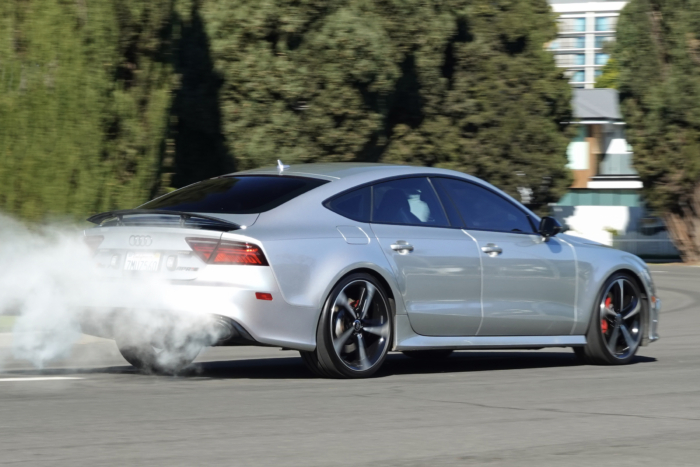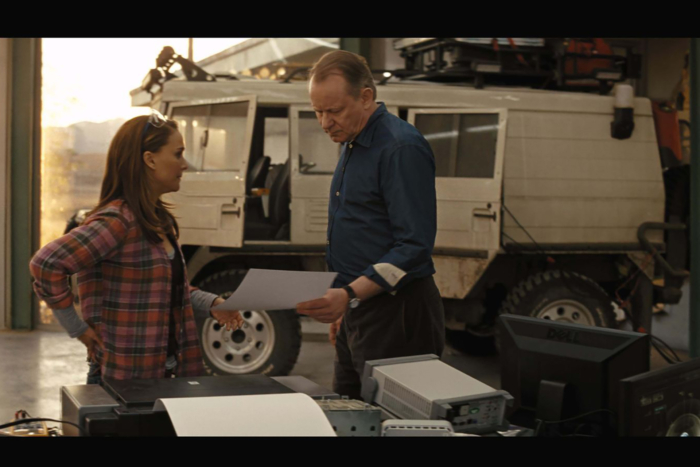It might seem like a no-brainer, but there’s a big difference between winter tires and all-season spinners. That’s what I learned after participating in a recent winter driving test on the snowy, windswept expanse of Yellowstone Airport.
The test, hosted by eBay Motors, included four different vehicles and four snow-covered courses. The goal? Showcase the different performance levels of winter tires versus their all-weather counterparts. I won’t bury the lead; as you’d probably guess, the winter tires came out on top.
But knowing that and experiencing it are two very different things. And to better understand both why and how winter tires outperform all-seasons, eBay gave me my very own professional driving instructor to sit shotgun. With the help of Shawn Umphries, a competitive multidiscipline racer and podium finisher at the Baja 1,000, I learned to find the limits of vehicles, tires, and conditions.
Testing Winter Tires With eBay Motors
From a pair of F-150 pickups to two Porsche 911 Carreras, the driving tests spanned four different vehicles, each in two variants — one with winter tires and one with a common set of all-seasons.
While results varied, based on driving skill and course obstacles, the consistent theme was that winter tires provide more traction and improved response to driver input across a variety of scenarios and driving contexts.
That said, there remains no substitute for common sense and safe, conservative driving in adverse conditions. After all winter tires aren’t miracle workers. They are better, but they are not a substitute for smart driving.

Snow-Cross Challenge: 2023 Ford F-150 Supercrew Lariat 5.0L 4×4
The Setup
To start, I piloted two nearly identical 2023 Ford F-150s, one with the winter tires and with all-seasons. But this test added a twist. The truck with all-season tires had 600 pounds of ballast in the bed — to test the common conception that trucks need extra weight in the back to combat fishtailing.
To help quantify the performance difference between the two setups, Umphries timed my best lap in each truck. All the while, he coached me on how to push the powerful F150 to its limits and put down the hottest laps possible.
The Outcome
Turns out, loading up a modern truck with extra weight is mostly counterproductive. While you gain some rear traction, you simultaneously pull weight off the front tires — you know, the ones that steer. I was guilty of this pickup truck misconception. Then again, my truck is over 20 years old.
By contrast, leaving weight over your front tires and swapping in proven winter tires can add noticeably more control over the vehicle. With Bridgestone Blizzak DM-V2 winter tires, I trimmed a full 13 seconds off my fastest time on the all-seasons.
SHOP BRIDGESTONE BLIZZAK Winter Tires
Moose Test Maneuvers: 2023 Chevrolet Blazer 2LT FWD
The Setup
The moose test was no joke — it simulated an unexpected lane change to avoid an obstacle (like a moose!). I drove a 2023 Chevrolet Blazer from a dead stop toward a cone barrier — the moose. As I approached, Umphries hollered out “left” or “right” — I was not told which ahead of time. My job was to react without braking to attempt to avoid contact with the cones using only steering and throttle inputs.
For this test, the winter tire Blazer had Continental VikingContact 7 treads.
The Outcome
While all-season tires suffice for many conditions, sudden inputs in snow will likely overwhelm their ability to maintain traction. The pivotal factor in the “moose test” that highlighted the difference in vehicle control between winter tires and all-season tires was the fact that we had to evade the obstacle without braking.
It’s tempting to tap that safety pedal when you know you’re part of a road test, but in real life, a surprise like an animal crossing might not allow that luxury. In all-season tires, I just couldn’t gather the Blazer back up, and when I tried, the wheels spun, and I lost even more control.
With the winter tire setup, a quick-swerve scenario did not result in losing control. Instead, the treads bit in and brought the back end in line, pushing me around the moose — not into it.


Ice Rink Rally: 2024 Toyota Camry SE FWD
The Setup
The aptly named Ice Course. The task is simple, even if the execution is not: Start from a stop on an icy runway, go through one chicane (“S”), and then accelerate until you hit the braking zone. Then, brake hard.
For this test, I piloted the 2024 Toyota Camry SE with slightly underinflated stock tires — a common tactic to increase a tire’s contact patch and improve traction — against the Yokohama iceGUARD IG53 winter tires.
The Outcome
This was dicey and perhaps the most eye-opening of all the tests. On glare ice, your car’s ability to accelerate from a stop is severely compromised. And when you feel the lack of traction, your overall ability to maneuver laterally is sluggish. By comparison, winter tires have a remarkable amount of purchase from a stop and provide much greater confidence in side-to-side turns.
But perhaps most importantly, while the rubber compound in a winter tire is designed to remain softer and grippier in sub-freezing temperatures, a car’s ability to stop on ice is dramatically impeded. A winter tire might save you a couple of feet, but there is no substitute for proper speeds and careful driving.


Slalom Showdown: 2023 Porsche 911 Carrera Cabriolet RWD
The Setup
Nothing says adrenaline like a slalom course, especially when testing the 2023 Porsche 911 Carrera’s agility with ultra-high-performance tires against the winter-optimized Pirelli Winter Sottozero Serie II.
This promised to be the most fun of our tests — let the Porsche’s performance characteristics shine on this speed- and suspension-tailored test.
The Outcome
High-performance tires might make your heart race on dry pavement, but winter’s icy grip can render them effectively useless. The 911 with performance treads was parked for the duration of the day, and I quickly learned why. Unless someone is there to give you a push, the Porsche’s power and weight work against tires on snow.
But with the special soft rubber compound and siping of the Pirelli Winter Sottozero Serie II, a high-performance car like the Carrera can at least maneuver through snow and ice. The car is still not the proper tool for the job, but in this instance, winter tires make the difference between a car that goes, and one that sits stranded.
SHOP Pirelli Winter Sottozero Serie II TiresBroad Takeaways
If, like me, you’ve viewed winter tires as a marginal gain for a prohibitive price, take my word for it: I was wrong.
Anyone who lives in a climate where winter driving is a fact of life would do well to invest in a set of winter tires — any winter tires. Special siping allows the tires to “bite” the snow, providing noticeable traction. And the softer rubber compound remains more supple and sticky on icy terrain.
There is absolutely no substitute for smart driving — but a good driver with winter tires is a winning combination.
About eBay Motors
Ebay Motors is a one-stop shop for millions of auto parts and accessories. It is the go-to source for any kind of tire imaginable, and with its new tire installation service, it’s never been simpler to buy your tires online and get them installed at your favored local auto shop.
LEARN MORE ABOUT EBAY MOTORS









